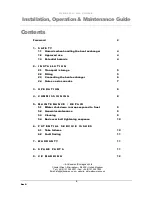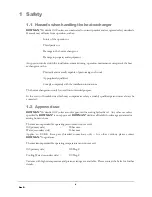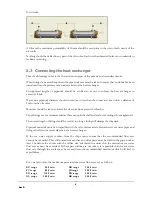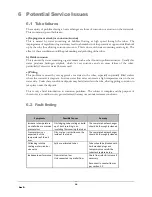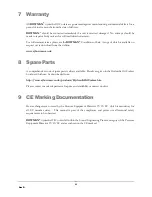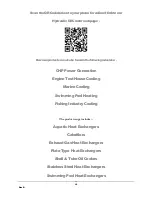
Rev D
7
No oil cooler manufacturer can guarantee that his products will have an indefinite life and for this
reason, we suggest that the cooling system is designed to minimise any damage caused by a leaking
oil cooler. This can be achieved as follows:
1.
The oil pressure should be higher than the sea water pressure, so that in the event of a leak
occurring, the oil will not be contaminated.
2.
When the hydraulic system is not being used, the coolers should be isolated from sea water
pressure.
3.
The sea water outlet pipe from the cooler should have a free run to waste.
4.
Stainless steel sea water pipes and fittings should not be used adjacent to the oil cooler.
Three Pass Bowman
Heat Exchangers
Oil cooler Max. sea
water flow
l/min
Orifice diameter in mm for max. sea water flow
series
1 bar
2 bar 3 bar
4 bar
5 bar 6 bar
7 bar 8 bar 9 bar
10
bar
EC
50
11
9.5
8.5
8
7.5
7.2
6.8
6.7
6.5
6.3
FC
80
14
12
11
10.0
9.5
9
8.7
8.4
8.2
8
FG
110
17
14
13
12
11
10
10
9.8
9.6
9.3
GL
200
23
19
17
16
15
14
14
13
13
13
GK
300
28
23
21
19
18
17
17
6
16
15
JK
400
32
27
24
22
21
20
20
19
18
18
PK
650
41
34
31
28
27
26
25
24
23
23
2.4 Notes on zinc anodes
The use of zinc anodes in heat exchangers has been employed for some years, generally by
manufacturers using admiralty brass tube or its variants. The purpose of the zinc anode, or zinc pencil
as it is sometimes called, is to prevent dezincification of the brass alloy tubes. As such zinc anode acts
sacrificially in favour of the tube.
There are a number of American and European manufacturers that use these anodes in their products.
Bowman, do not fit zinc anodes as the tubes used in the construction of our coolers are of copper nickel
alloy and as such do not require a zinc anode. It is possible that if this anode is fitted it can actually
destroy the copper oxide film built up by the tube as a natural defence which can allow the tube material
to be attacked.
It is usual with the copper nickel alloys to use an iron anode which allows an iron oxide film to build up
inside the tube which breaks down as a sacrificial element reducing the possibility of corrosion to the
heat exchanger. In Bowman designs it is not practical to fit iron anodes as their size has to be very
generous. Therefore as an alternative a piece of black iron pipework can be placed before the heat
exchanger which in itself acts as sacrificial element protecting the cooler. The Royal Navy has often
used this technique and when the black iron pipework corrodes, it is simply replace with a fresh piece.
We do know that some manufacturers of heat exchangers, mostly those providing copies of the better
known products, often fit zinc anodes incorrectly with copper nickel alloys in error.



